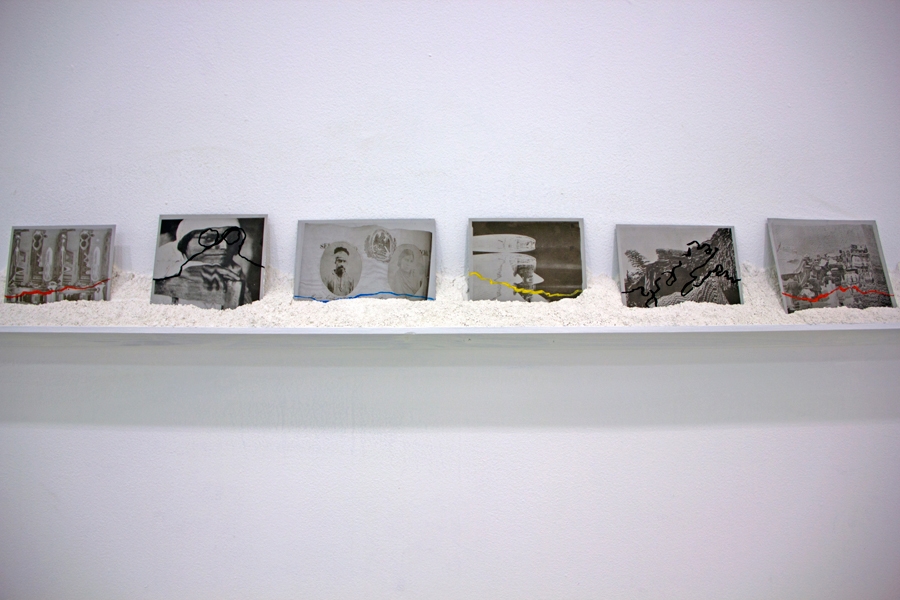Taking as its pretext an exhibition about the history of photography in Mexico that was staged last year at MUNAL (Museo Nacional de Arte), Mexico City, Félix Luna’s work Espejos Opacos (Opaque Mirrors, all works 2014) elegantly interrogates the very essence of the medium. Making his own selection with the help of his friend historian-turned-curator Andrés Aguilera Patiño and distorting the images manually through mechanical modifications, Luna reveals a parallel narrative that questions official history. The images he has rephotographed and distorted create phantasmagoria, mirages. It is no coincidence that the artist highlights and problematises the fact that the daguerreotype is a sort of mirror, as the MUNAL exhibition was intended to be a mirror of history through its photos. Luna shows us that, more often than not, the mirror is opaque.
His selection begins with the first daguerreotype ever taken in Mexico. It’s a choice that immediately brings into question the construction of so-called national history: while the image was shot here, it had to be taken to Europe to be developed (using silver imported from the New World), only to be sent back to Mexico again. Here is global capital and postcolonial schadenfreude revealed in one click.
The selection then moves on in groups of black-and-white photographs spanning 1839 to 1940, their continuity traced or drawn by the artist in squiggles and lines in CMYK – the subtractive colours that are precisely absent from these prints. A quick visit to the artist’s studio downstairs reveals that for him, magenta stands for ‘keep’, black, or key, for ‘archive’, cyan for ‘discard’ and yellow for ‘forget’, and it would seem that this sort of arbitrary mechanism is the mechanism of history-making itself. It’s also interesting to note that the blue (hi)story line is the one that was used ‘officially’ at the MUNAL exhibition.
Placed on a long shelf, Luna’s narrative selection spans the four walls of the gallery, and in it he has chosen to turn progress on its head, literally: any image having to do with factories, mining, labour, etc, is upside-down. The rest of the photos are all placed ‘normally’ in groups that tell stories (or not) and some have been removed, leaving a blank space: a marked emptiness. These removed images are all to be found on the floor in small piles located at the four cardinal points.
The artist has chosen to remove any clichés (again literally) and portraits of famous ‘heroes and villains’, leaving us, in a way, with a more unofficial and unglorified, often ‘truer’ version of history, where Durango becomes Durangogo (due to manipulation of the image scan), or where the railroad under a group of lynched Catholics seems to become a river, surely the Styx. All the images are lying on a bed of quicklime, or calcium oxide, which is the material used by miners who extract silver – the same silver used to make daguerreotypes and, of course, most of analogue photography up until relatively recently – to neutralise the toxic chemicals used in its separation from other minerals. This becomes a double neutralisation – not just the symbolic one of the cyanide and other toxic chemicals, but the neutralisation of the images themselves through their placement on this white dust: nothing makes ‘sense’ in the traditional way any more.
As a sort of prelude, Hay Ausencias Que Representan un Verdadero Triunfo (There Are Absences That Represent a Real Triumph) is another, more literal extraction: that of a brick, taken by the artist from Lecumberri, an infamous former prison in Mexico City, which now holds the national archives. This action is documented in silkscreens, exhibited as such and is therefore as hard to read as truth itself.
And finally, as counterpoint to these two extractions, the show also has an inclusion: in the centre of a huge darkened room, a single light illuminates a small golden disc: the base of an inserted upside-down bronze sculpture cast from the hole that the artist made in the floor and into which he has reinserted the sculpture to almost perfectly fill the gap. The sculpture is invisible, and one can only see it online, in a YouTube video documenting the process – elsewhere, not here.
Absence and presence – the question of photography – and inclusion and exclusion – the question of history – converge in these habitable events or ephemerides, if only for the brief moment of the exhibition.
This article was first published in the May 2014 issue.
